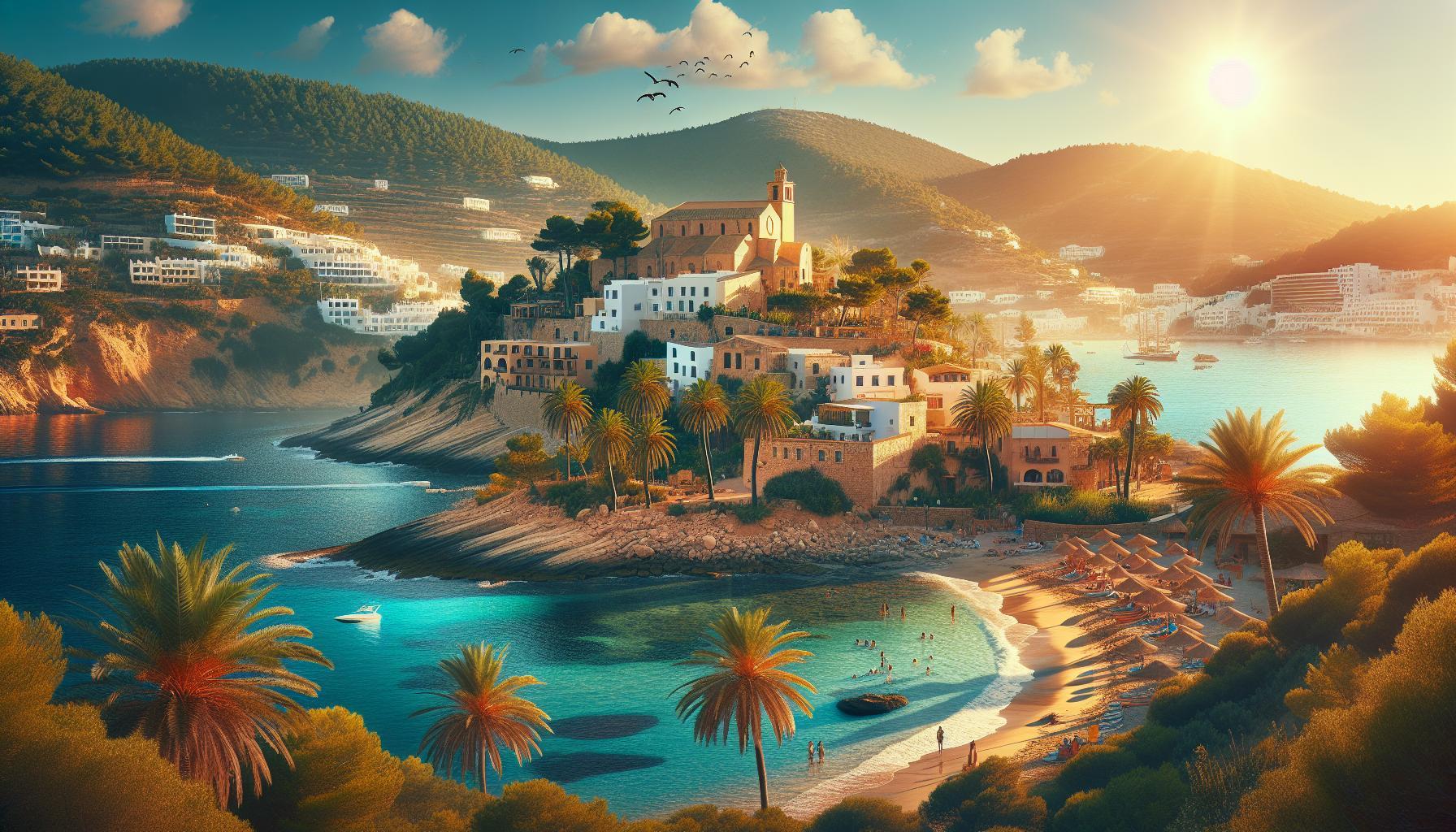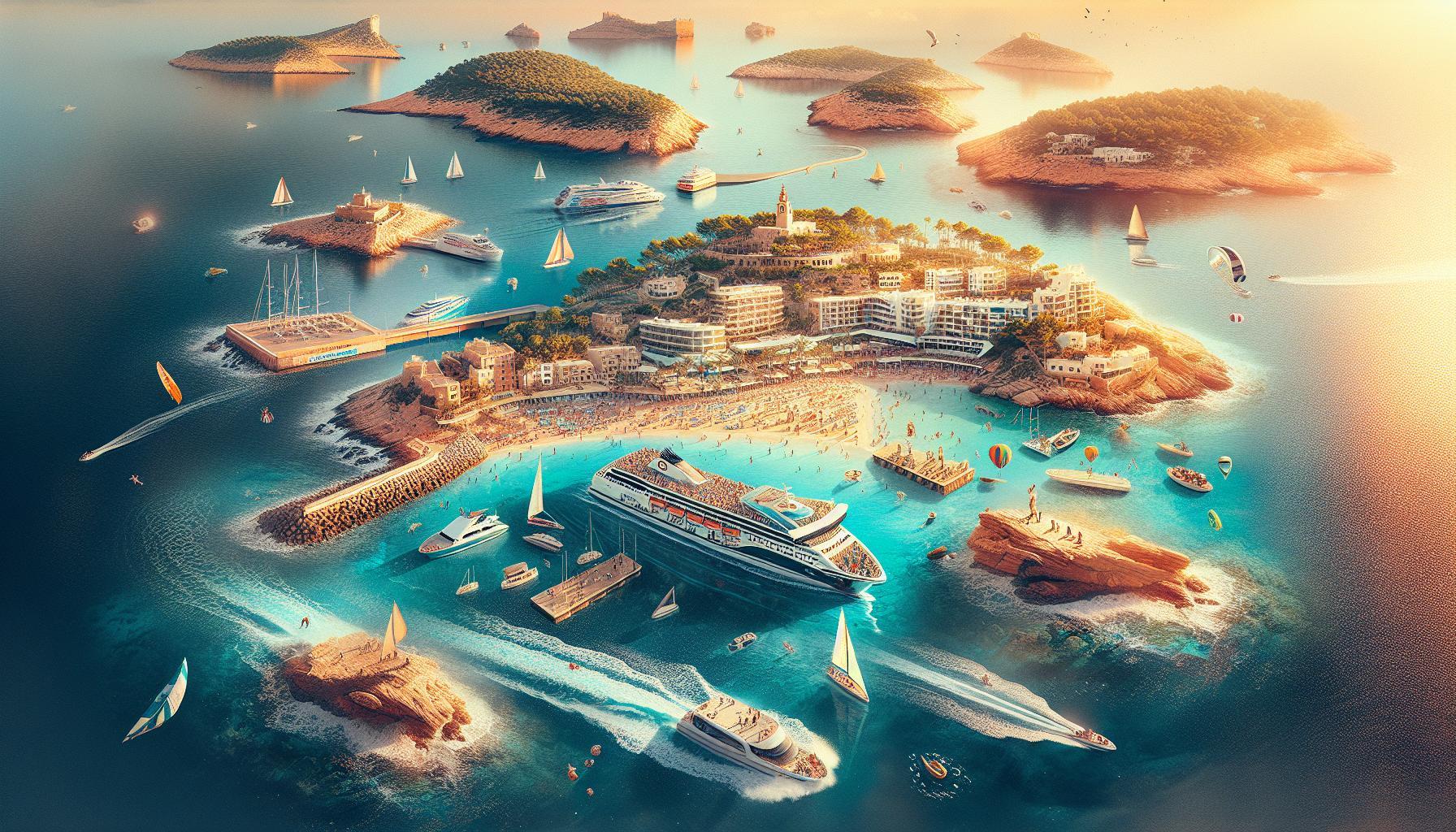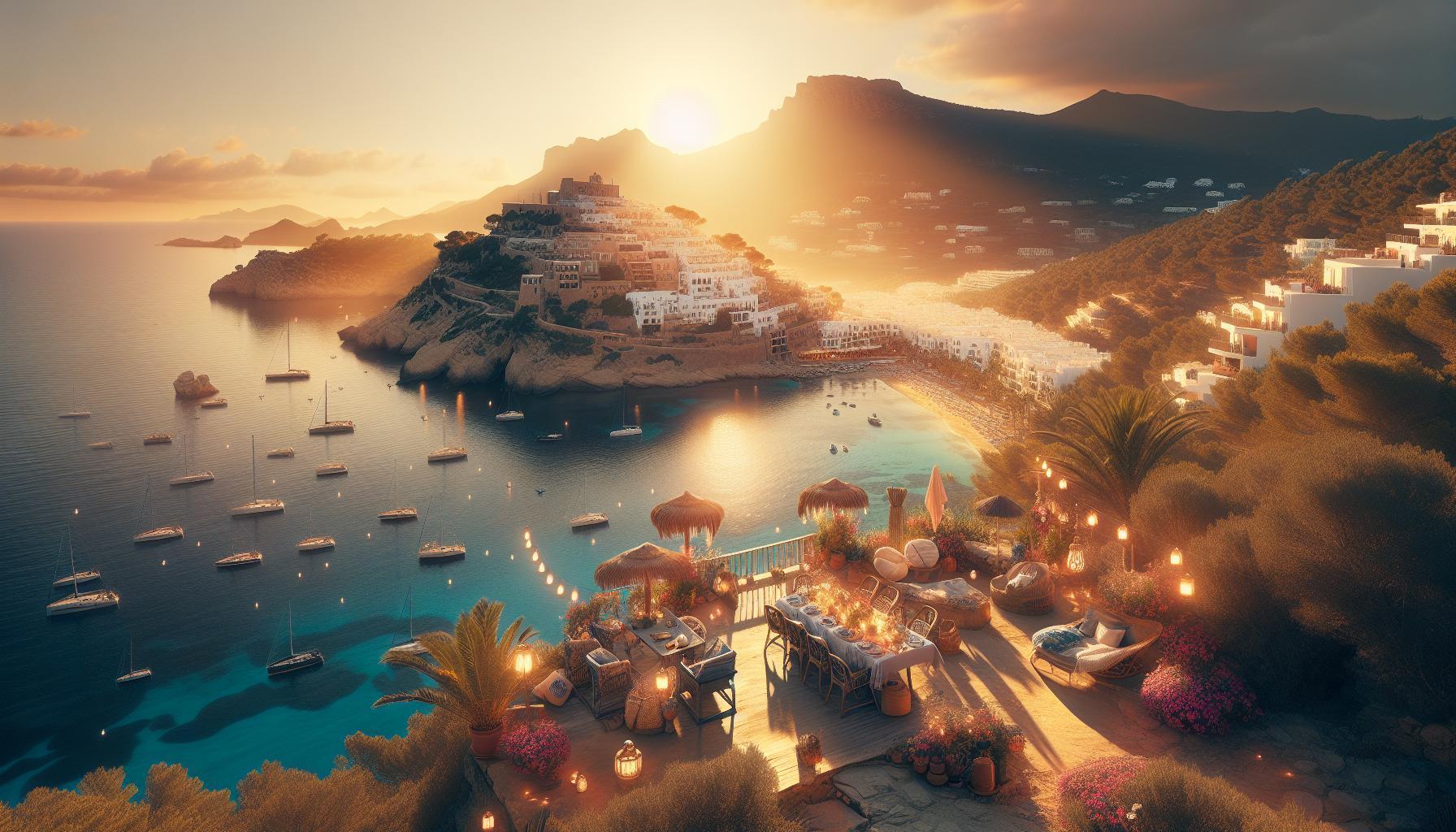Ibiza’s stunning landscapes and rich geological history often prompt the question: is this famed island a product of volcanic activity? Understanding Ibiza’s geology is crucial, as it reveals not only the island’s natural wonders but also its unique ecological significance.Dive into the fascinating geological features that shape this Mediterranean gem, exploring its diverse rock formations and earth’s history.
Unveiling Ibiza’s Geological Story: A Journey Through Time
Ibiza,often celebrated for its vibrant nightlife and stunning beaches,holds a secret beneath its sandy shores: a rich geological history that traces back millions of years.Unlike many islands in the Mediterranean, Ibiza is not volcanic but is instead characterized by its unique geological structure. The island primarily consists of Mesozoic faulted and folded materials, forming a stunning landscape of gentle hills known as Amunts and picturesque valleys, making it a fascinating destination for those curious about earth science and natural wonders.
Exploring the island’s geological features reveals a compelling narrative shaped by considerable geological processes.Ibiza can be understood as a horst, which is a raised block of the earth’s crust that has been lifted relative to its surroundings. This distinctive formation contrasts sharply with nearby Formentera, which exists as a corresponding graben, highlighting the complexities of tectonic movements in the region. The interplay between these geological formations creates diverse ecosystems and stunning topography that make the island captivating to both geologists and casual visitors alike.
In addition to its structural formation, the vegetation and sediment found in Ibiza’s valleys tell a different story of natural history. Quaternary materials outcrop in these valleys, offering vital clues to past climatic conditions and environmental changes. The island’s rocky coasts have also been shaped by boulder deposits attributed to significant storm events and potential tsunami activity, which further emphasizes the dynamic nature of Ibiza’s geological landscape.When you visit Ibiza, consider exploring some of its lesser-known geological sites. Hiking the Amunts not only provides breathtaking views but also a chance to witness the intricate rock formations and learn more about the island’s geological story. Whether your a hiking enthusiast or a casual beachgoer, taking a moment to appreciate the island’s geology can deepen your understanding of Ibiza as more than just a party destination but as a place steeped in natural history and beauty.
The Volcanic Origins of Ibiza: Fact or Fiction?
Ibiza, renowned for its vibrant nightlife and stunning landscapes, frequently enough sparks curiosity about its geological origins. One common question arises: Is Ibiza a volcanic island? While the alluring beaches and picturesque cliffs might suggest a volcanic past, the truth is more nuanced. The island is primarily a product of geological activity that predates any volcanic formation.
The geology of Ibiza reveals a complex history that is not rooted in volcanic activity but instead in a mixture of different geological processes. The island itself is classified as a horst, a raised block of the Earth’s crust, while nearby Formentera corresponds to a graben, or a block that has dropped. Its composition is largely Mesozoic in origin,featuring faulted and folded materials that create the gentle hills known as the Amunts,with valleys containing Quaternary materials. These geological formations suggest a landscape shaped by extensive tectonic activity rather than volcanic eruptions.
Common misconceptions and Geological Facts
There are several misconceptions about the volcanic origins of Ibiza, which can be clarified with some key geological facts:
- No Active Volcanoes: Unlike many islands in the Mediterranean, Ibiza does not host any active or dormant volcanoes.
- Structural Features: The prominent cliffs and coves of the island are a result of erosion and sedimentation, rather than volcanic processes.
- Mesozoic Rocks: The primary rock types found on Ibiza are limestone and dolomite, which are sedimentary in nature, further debunking the volcanic narrative.
Understanding the geological background of Ibiza not only enriches the experience of visiting this picturesque island but also illustrates the fascinating interplay of natural forces that shaped its current form.For those keen on exploring Ibiza’s landscapes, awareness of its true geological identity—distinct from the volcanic origins often presumed—can enhance their recognition of its natural wonders.
Exploring Ibiza’s Unique Rock Formations: Nature’s Artwork
The rugged coastline of Ibiza is a spectacular canvas illustrating the geologic history of this Mediterranean island, showcasing nature’s artistic touch through its striking rock formations. Among these, the unique shapes created by erosion and the remnants of ancient quarrying processes stand as silent witnesses to the island’s vibrant past.As visitors explore these natural wonders, they will encounter elements that evoke creativity, with some rocks resembling sculptures of fish, Buddhas, and flowers, each symbolizing the harmonious coexistence of nature and human creativity.
A Journey Through Time
One of the most captivating sites is Sa Pedrera de Cala d’Hort, also known as the Atlantis of Ibiza. This area was once a quarry where sandstone was cut to build the city walls of Dalt Vila, now a UNESCO World Heritage Site. The layered rock formations create small natural pools, ideal for a refreshing dip after a hike through these captivating landscapes. The remnants of the quarrying activity, combined with the sounds of the waves crashing against the rocks, provide a serene backdrop that invites contemplation and exploration.
- Experience the Shapes: Imagine walking among rocks that look like they were sculpted by an artist’s hand—each contour tells a story.
- refresh in Natural Pools: Take a break in the crystal-clear waters that collect in pockets between the rocks.
- Photography Paradise: Don’t forget your camera; the interplay of light and shadow on these formations creates stunning photographs at sunset.
Accessing the Natural Artwork
To explore these majestic rock formations,visitors can choose from several trails leading to Sa Pedrera. It is indeed advisable to wear sturdy footwear,as some paths can be rocky and steep. Along the way, be sure to pay attention to the diverse flora and fauna that thrive in this unique ecosystem. While the beauty of Ibiza is often associated with its beaches and nightlife, the geological wonders present a quieter, yet equally captivating side of the island.
Engaging with Ibiza’s unique geology offers not only a glimpse into the island’s natural history but also an possibility for personal reflection amidst stunning vistas. If you’re pondering, “Is Ibiza a volcanic island?” it’s essential to understand that while it is not volcanic in origin, its geological features harbor a rich narrative shaped by both natural processes and ancient human activity, making the exploration of its rock formations a vital part of experiencing Ibiza’s allure.
discovering Ibiza’s Hidden Caves and Natural Wonders
Exploring the enchanting landscapes of Ibiza reveals a hidden world beneath its sun-soaked surface, showcasing the island’s geological wonders that are both ancient and breathtaking. Among these hidden treasures are the remarkable caves that speak of Ibiza’s volcanic origins and vibrant ecosystems. The island’s unique geology,shaped by volcanic activity millions of years ago,has created remarkable formations that are waiting to be discovered.
Can Marça Caves
the Can Marça Caves, located in the north of Ibiza, provide a perfect window into the island’s geological past. This enchanting underground space draws visitors into a fairy tale world where natural formations have been shaped over eons. When visiting, you can witness stunning stalactites and stalagmites, vibrant colors, and listen to the cascading water that has carved these tunnels.It’s not only a visual feast but an opportunity to understand the natural history that has formed these captivating spaces. Make sure to explore the guided tours available that delve into both the geological aspects and the myths surrounding these iconic caves [1[1[1[1].
Ullal de na Coloms – The Cave of Light
Another gem is the Ullal de na Coloms, also known as the Cave of Light. This fascinating cave is a marvel of nature, characterized by a massive opening in its roof that allows sunlight to flood the interior, creating an awe-inspiring spectacle. Visitors can explore this cave and experience its illuminative beauty, which is markedly different from the traditional deep and dark cave systems. this natural phenomenon not only highlights Ibiza’s unique geology but also offers a serene escape, perfect for photographers and nature lovers alike [2[2[2[2].
other Hidden Wonders
Beyond the well-known caves, Ibiza houses several other secret coves and inaccessible areas that beckon adventurous souls. As an example, secret coves near Cala Tarida, surrounded by steep cliffs and lush landscapes, offer an opportunity to unwind away from the bustling tourist spots. These locales are perfect for a family outing or a peaceful day basking in the sun, enjoying the unspoiled beauty of Ibiza’s coastline [3[3[3[3].
Ibiza’s hidden caves and natural wonders provide a unique experience that intertwines geology with natural beauty. Whether it’s exploring the mystical can Marça Caves or basking in the ethereal light of Ullal de na Coloms, each site tells a story of the island’s volcanic roots and ecological richness.For adventurers looking to delve into the heart of Ibiza’s landscape, these natural wonders are not to be missed.
The Influence of Ibiza’s Geology on Its Diverse Ecosystems
Formed from a complex interplay of geological forces, the island of Ibiza showcases a unique and captivating natural landscape that significantly influences its diverse ecosystems. While the popular narrative may question whether Ibiza is a volcanic island,its geological origins are rooted in sedimentary processes with evident limestone formations and rocky coastlines that play a crucial role in supporting rich biodiversity.
Geological Features and Ecosystem growth
The predominant geological formations of ibiza are primarily made up of limestone, which originated from ancient marine environments. This limestone contributes to the creation of various habitats, including cliffs and coves, that provide shelter and breeding grounds for numerous species. The shallow waters between Ibiza and Formentera, rich with dense prairies of Posidonia oceanica—a seagrass endemic to the Mediterranean—further illustrate how the island’s geology fosters ecological variety. These meadows are vital for marine life, offering essential nutrients and protection to diverse fish species, crabs, and mollusks, while also being a crucial nesting site for various bird species.
- Marine Ecosystems: The posidonia beds serve as a natural filter, improving water clarity and quality, which is essential for other marine organisms.
- birdlife: Saltpan lagoons and coastal areas created by geological formations provide pivotal habitats for migratory birds, thus enhancing biodiversity.
Impact of Coastal Erosion and Marine Influence
Coastal erosion, a natural process that shapes Ibiza’s shores, is influenced by the island’s geological structure. Erosion not only reveals historical geological layers but also creates new habitats that benefit different marine species. The interaction between land and sea is crucial in defining the ecological balance on the island. As a notable example, the continual shifting of coastal landscapes due to lithological changes fosters unique microhabitats, offering refuge to specialized species that have adapted to these environments.
Practical Implications for Conservation
understanding the geological aspects of Ibiza is essential for conservation efforts aimed at preserving its rich biodiversity. Protecting key geological sites can help maintain the nutrient flow essential for ecosystems supported by Ibiza’s unique geology. Sustainable tourism and conservation policies should consider these geological features, ensuring that both visitors and local communities cherish and protect the natural wonders that Ibiza’s geology offers.
By recognizing how the island’s geological structure interacts with its ecosystems, we can appreciate the complexities of Ibiza’s habitat, leading to informed decisions that safeguard this UNESCO World Heritage site for future generations.
Coastal Marvels: How Ibiza’s Geologic Features Shape Its Beaches
Ibiza is not only recognized for its vibrant nightlife and stunning landscapes but also for its intriguing geological characteristics that significantly influence its coastal formations. The island, largely composed of Mesozoic rock layers, has a fascinating geological history that shapes its beaches and shorelines. As you stroll along the golden sands, it’s essential to appreciate how the island’s unique topography and geological features contribute to the overall coastal experience.
Formation of Beaches
The beaches in Ibiza owe their distinct appearances to the island’s geological structure. ibiza features a combination of soft sandy beaches and rugged cliffs, with sandy areas primarily found in shallow bays and coves. The Amunts, gentle hills formed from faulted and folded materials, dictate the layout of the coastline, leading to a variety of beach environments:
- Coves: Small, sheltered beaches that provide tranquility, perfect for swimming and relaxation.
- Cliffside Beaches: Dramatic drop-offs that offer stunning views but are often less accessible.
- Sandy Bays: More expansive and popular among tourists,ideal for sunbathing and water sports.
Influence of Erosion and Sedimentation
The dynamic interplay between the forces of erosion and sedimentation plays a vital role in shaping Ibiza’s coastal marvels.Coastal erosion, driven by waves and weather patterns, continuously reshapes the beaches and cliffs, while sedimentation helps to replenish and create new sandy areas. Visitors can witness this fascinating process in real time as they explore various parts of the coastline, from the bustling beaches of Playa d’en Bossa to the serene landscapes of cala Comte.
Geological Wonders Beyond the Beaches
beyond the sandy shores, Ibiza’s geological features extend underwater, with vibrant marine life thriving in the rich ecosystems formed by its unique rock structures. The underwater cliffs and seagrass meadows present at many beach locations support diverse marine species, inviting snorkeling and diving enthusiasts to explore the underwater world. Engaging in these activities not only enhances the experience but also fosters a deeper appreciation for the island’s geology and natural wonders.
embracing the diverse geological features of Ibiza enhances the overall experience of its beaches. Whether you’re enjoying a relaxed day at a cove or indulging in thrilling water sports at a sandy bay, remember that the landscape around you is a tapestry woven from millions of years of geological history.
A Local’s Guide to Ibiza’s Natural Attractions: Beyond the Nightlife
Ibiza is often celebrated for its vibrant nightlife and world-renowned clubs, but this enchanting island also harbors a variety of stunning natural attractions that can captivate anyone seeking solace in nature. A closer look reveals its volcanic origins, which have shaped not only its breathtaking coastlines but also its rich ecosystems, making it a must-explore destination for those yearning for tranquility amidst stunning geological wonders.
The volcanic Origins and Natural Wonders
Is Ibiza a volcanic island? Indeed, the geology of Ibiza reveals a fascinating history of volcanic activity that has formed its rugged landscape. the presence of volcanic rocks and mineral-rich soils supports diverse flora and fauna that thrive in this unique environment. Visitors can explore the intricate relationship between the island’s geology and its natural beauty, from the striking cliffs of Es Vedrà to the serene white-sand beaches tucked away in secluded coves.
Some must-visit natural attractions include:
- Es Vedrà: A mystical rock formation off the southwestern coast, offering breathtaking views and intriguing legends.
- The caves of Can Marçà: These fascinating caves in the north are not only a geological wonder but also provide insight into the island’s history.
- Las Salinas Natural Park: A UNESCO Biosphere Reserve, known for its vibrant salt flats and diverse wildlife, perfect for birdwatching.
- Benirrás Beach: Famous for its unique sunset drumming rituals, this beach also boasts lovely rock formations, a stunning shoreline, and clear waters.
Exploring Ibiza’s Natural Diversity
Along with its volcanic features,Ibiza is home to myriad natural parks and protected areas that preserve its ecological diversity. The nature reserve of Es Vedrà, Es Vedranell, and nearby smaller islands are vital habitats for various marine and terrestrial species. this protected zone features cliffs, scenic beaches, and lush forests, making it a paradise for hikers and nature lovers alike.
If you want to explore Ibiza’s hidden gems, consider planning a day trip to areas such as:
- Santa Eulària des Riu: Known for its tranquil beaches and lush green landscapes, perfect for picnics and relaxation.
- Cala d’Hort: Offers stunning views of Es vedrà and is a great spot for swimming and sunbathing.
These natural attractions showcase that Ibiza is much more than its nightlife; it is indeed a vibrant living landscape steeped in geological history.Embrace the island’s natural wonders and immerse yourself in the peaceful ambiance, which can be just as exhilarating as any night out in the club scene.
Savoring Ibiza’s Landscapes: top Spots for Stunning Views and Adventures
The diverse landscapes of Ibiza offer a captivating array of views and adventures that can make you feel as though you are on a natural wonderland. With its rugged coastline, lush hillsides, and hidden coves, the island is a testament to its intriguing geological history, which has been shaped by various forces over millions of years. From the moment you step foot on the island, it’s easy to see why many are drawn to its beauty and adventure-filled opportunities.
Best Viewing Spots
To truly savor Ibiza’s majestic vistas, there are several prime locations for stunning views:
- Es Vedrà: This iconic rock formation rises dramatically from the sea, offering breathtaking sunset views. Legends abound about Es Vedrà, often described as mystical, adding a layer of enchantment to your visit.
- Cap de Formentor: Although technically part of neighboring Mallorca, the viewpoint at Cap de Formentor is accessible by boat or a short trip, providing panoramic views of the bay and dramatic cliffs.
- Sa Talaia: As the highest point on the island, hiking to Sa Talaia rewards adventurers with a sweeping view of Ibiza and its surrounding waters.
Adventure Activities
Ibiza is not just about soaking in the views; it is indeed also a hub for thrilling activities that allow visitors to connect with nature more intimately.
- Hiking: Explore numerous trails like the path from Cala d’Hort to Es Vedrà which offers both exercise and a picturesque backdrop.
- Snorkeling and Diving: The waters surrounding Ibiza are teeming with marine life. The beaches of Cala Xarraca and Aguas Blancas are perfect for snorkeling adventures, showcasing vibrant coral reefs and fish.
- Kayaking: Paddle along the coast to access hidden sea caves and solitary beaches that are often missed by larger crowds,providing a unique viewpoint of Ibiza’s striking geology.
Whether you’re scaling the heights of Sa Talaia or leisurely kayaking to a secluded cove, Ibiza’s top spots for stunning views and adventures are as varied as its geological story. engaging with these natural wonders not only enriches your travel experience but also connects you with the island’s history and beauty, answering the curious question: Is Ibiza a volcanic island? Through these explorations, one discovers that the answer lies within the very landscapes they traverse.
Frequently Asked Questions
Is Ibiza a volcanic island?
No, Ibiza is not a volcanic island. It is part of the Balearic archipelago in the Mediterranean Sea and primarily consists of limestone, a sedimentary rock formed over millions of years.
Ibiza’s geological history dates back to the mesozoic Era, characterized by marine environments that shaped its current landscape. The island features gentle hills and valleys,known as Amunts and “sava” valleys respectively,adding to its natural beauty without volcanic formations.
What is the geology of Ibiza?
The geology of Ibiza is fascinating, mainly composed of Mesozoic era rock formations, with faulted and folded limestone. This composition creates a unique landscape filled with valleys and coastal cliffs.
These geological features have influenced the island’s ecology and local biodiversity, making it a great place for nature enthusiasts to explore. The Quaternary materials in the valleys further show the diverse geological history of ibiza. For more insights, check our section on Ibiza’s natural wonders.
Why does Ibiza have such diverse landscapes?
Ibiza’s diverse landscapes result from its complex geological history and erosion over time. Its unique limestone formations, shaped by natural processes, create hills, valleys, and stunning coastlines.
This geological variety allows for different ecosystems to thrive, from rocky cliffs to sandy beaches. Such a landscape invites visitors to enjoy hiking, beach days, and picturesque views around the island.
Can I find fossils in Ibiza?
Yes, fossils can be found in Ibiza, especially within its limestone rock formations. These ancient remains provide insight into the island’s geological past and the types of life that existed.
Visitors interested in paleontology can explore areas known for fossil deposits, although proper permissions and respect for nature should always be maintained. Discovering these remnants adds an exciting layer to the island’s rich natural history.
What natural wonders can I see in Ibiza?
Ibiza boasts incredible natural wonders, including stunning limestone cliffs, hidden coves, and vibrant marine life. The island’s geological formations create breathtaking views that are perfect for photography.
Don’t miss visiting destinations like Es Vedrà, a mystical islet with dramatic cliffs, or the serene beaches along the coast. exploring these natural wonders showcases Ibiza’s beauty beyond its nightlife scene.
How do I explore Ibiza’s natural landscapes?
Exploring Ibiza’s natural landscapes can be done through hiking, biking, or simply driving around the island. Many trails offer breathtaking views and access to less-visited areas.
Popular routes include paths around the Amunts, showcasing the island’s unique flora and fauna. Always remember to equip yourself with water and sun protection for a safe adventure while enjoying the island’s stunning vistas.
Why is Ibiza important for biodiversity?
Ibiza is crucial for biodiversity due to its variety of habitats, from coastal zones to inland forests. Its unique geological structure supports numerous species of flora and fauna.
This ecological diversity not only contributes to the island’s picturesque landscapes but also supports local agriculture and marine life.Protecting these zones is essential for sustaining the biodiversity that enriches Ibiza.
What are the best activities related to Ibiza’s geology and nature?
Engaging in activities like hiking,snorkeling,or visiting geological sites allows visitors to appreciate Ibiza’s natural beauty and geology. Exploring the island’s coves and coastal formations can be notably rewarding.
Many guided tours focus on ecology and geology, providing informative insights into the island’s history. Whether you’re a nature lover or an adventure seeker, Ibiza offers plenty to enrich your experience.
Future Outlook
As we journey through the fascinating geological tapestry of Ibiza, we uncover the island’s unique charm that extends far beyond its vibrant nightlife and sun-soaked beaches. While not a volcanic island, Ibiza’s rugged cliffs and stunning landscapes tell a story of sedimentary layers shaped over millennia, reflecting a rich history influenced by tectonic movements and natural erosion. Picture yourself wandering along the picturesque shores, feeling the warm sun on your skin and the cool ocean breeze as you marvel at the dramatic coastline carved by ancient forces.
Don’t miss the opportunity to explore Ibiza’s hidden treasures—like the serene coves and untouched natural parks that offer a breath of tranquility. Whether you’re a party enthusiast dancing under the night sky, a family seeking adventure in nature, or a luxury traveler indulging in the island’s upscale offerings, Ibiza welcomes you with open arms. So, lace up your walking shoes, grab your camera, and get ready to uncover the authentic spirit of Ibiza—a place where every corner holds a new adventure waiting to be discovered.Dive into the mesmerizing mix of geological wonders and vibrant culture, and let your Ibiza adventure begin!









